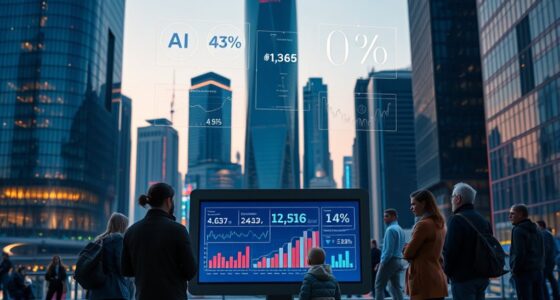Media bias often heightens your anxiety about automation by focusing on job losses and AI mistakes, making these threats seem more urgent and threatening. News stories tend to highlight worst-case scenarios, which can lead you to feel overwhelmed or distrustful of technological progress. When media outlets appear biased, your concerns may grow even more, reinforcing fears about societal impacts. If you keep exploring, you’ll discover ways media influence your perceptions and how to approach automation more calmly.
Key Takeaways
- Media bias emphasizing job losses and errors heightens public fears about automation replacing human workers.
- Negative headlines and sensational stories amplify feelings of helplessness and emotional distress related to automation.
- Skewed coverage fosters distrust, leading people to perceive automation news as exaggerated or biased.
- Balanced reporting on automation’s benefits and challenges helps reduce anxiety and promotes a nuanced understanding.
- Media bias can distort perceptions of automation’s societal impact, increasing perceived threats and social stress.

Media bias plays a significant role in shaping how automation is perceived by the public, often fueling anxiety about job security and technological change. When news outlets focus heavily on the negatives of automation, like widespread job losses or AI errors, it intensifies fears that machines will soon replace human workers. This skewed portrayal can make you feel overwhelmed, especially if you’re already worried about your job or uncertain about the future. The media’s tendency to highlight worst-case scenarios tends to amplify these fears, making automation seem more threatening than it might actually be.
However, advances in AI journalism are beginning to change this narrative. AI tools can evaluate news content objectively, helping reduce perceived media hostility. By providing more balanced and fact-based reporting, AI can help you see automation in a clearer light—highlighting both its benefits, like efficiency and innovation, and its challenges. When media coverage becomes more objective, it can lessen the anxiety many people feel about the rapid technological changes affecting work and society. Unfortunately, public distrust in media fuels these concerns further. If you’re skeptical of the information you consume, you’re more likely to interpret automation news as biased or alarmist, which increases your sense of vulnerability.
The way automation is covered also impacts your mental health. Negative portrayals, especially those emphasizing job losses or AI errors like deepfakes, can lead to feelings of helplessness, frustration, or even depression. When news repeatedly highlights automation’s potential to displace workers, you might develop a pessimistic outlook, perceiving the future as bleak. Inconsistent coverage adds to this uncertainty, making it difficult to gauge whether automation will truly benefit or harm society. This inconsistency fuels anxiety because you can’t easily predict or understand the true impact of technological progress.
Media bias also spreads misinformation, making you more anxious by presenting skewed or exaggerated stories about automation. When sensational headlines dominate, they can distort your perception of how AI and automation truly affect jobs and social stability. Conversely, balanced reporting that includes the potential advantages of automation, like improved productivity and new job opportunities, can help you develop a more nuanced view. When the media presents automation as both a challenge and an opportunity, you’re less likely to feel overwhelmed or helpless.
Ultimately, the way media covers automation influences your emotional response and social attitudes. Biased narratives can create stress, frustration, and a sense of injustice, impacting your mental well-being. But with more objective and all-encompassing reporting, you can better understand automation’s complexities and reduce feelings of fear and uncertainty. Recognizing the role media bias plays in shaping your perception is the first step toward developing a more informed and balanced view of technological change.
Frequently Asked Questions
How Do Different Media Outlets Portray Automation Impacts?
You see how media outlets portray automation impacts in various ways. Some highlight job displacement and societal disruptions, fueling fears, while others emphasize technological progress and economic growth, fostering optimism. Negative coverage often amplifies worries about inequality and job loss, whereas positive framing showcases innovation and efficiency. Your perception is influenced by these portrayals, which can either heighten or reduce your anxiety about automation’s role in the future.
What Role Does Social Media Play in Shaping Automation Fears?
Did you know that about 30% of social media users worldwide report feeling more anxious? Social media plays a significant role in shaping your automation fears by amplifying negative stories and creating echo chambers. It often highlights worst-case scenarios, making you worry more about job security. The emotional storytelling and influencer opinions can strengthen your fears, creating a cycle where increased anxiety leads you to seek out more automation-related content.
Are There Specific Demographics More Influenced by Media Bias on Automation?
You should know that certain demographics are more influenced by media bias on automation. Younger people, exposed more to social media, often face higher anxiety levels. Women and racial or ethnic minorities might also be more affected due to biased portrayals. Socioeconomic status influences access to diverse news, affecting susceptibility. Recognizing these differences helps you better understand how media bias shapes your perceptions and worries about automation’s impacts.
How Can Consumers Identify Biased Reporting on Automation Topics?
Think of biased reporting as a distorted mirror, reflecting a skewed image of automation. To spot it, pay attention to emotive language, selective story coverage, and sources quoted. Cross-check stories with multiple outlets to see different angles. Watch for overly positive or negative tones, and question the motives behind the narrative. By staying vigilant and seeking transparency, you can cut through the fog of bias and see the true picture clearly.
What Are the Long-Term Effects of Media Bias on Public Policy Regarding Automation?
You need to understand that media bias markedly influences public policy on automation over time. It skews perceptions, leading to reactive regulations and increased polarization. This can cause legislative gridlock, focus on sensational issues, and erode trust in institutions. As a result, policies may prioritize control rather than innovation, making it harder for balanced, effective automation strategies to develop. Bias ultimately hampers informed decision-making and democratic engagement.
Conclusion
As you scroll through headlines, you see the storm clouds of media bias gathering, casting shadows over automation’s promise. The vivid lightning strikes of fear and doubt illuminate a path lined with uncertainty, making you feel small in a vast, swirling sky of misinformation. But remember, behind those clouds, the sun still shines with innovation and opportunity. By questioning what you see, you can clear the skies and find your way through the storm of automation anxiety.








